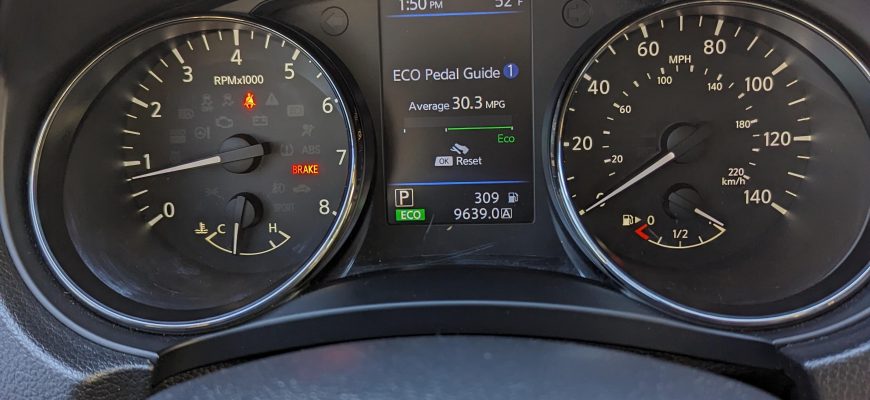The dreaded “low fuel” light. That moment of anxiety when you wonder: how much further can I realistically go before I need gas? While your car’s fuel gauge provides a general idea, it’s often not precise, leading to potentially stressful situations. Understanding your car’s actual range and the factors influencing it requires a blend of real-world testing and a little bit of math.
Understanding Your Car’s Fuel Economy
Your car’s fuel economy, measured in miles per gallon (MPG), is the cornerstone of range calculation. This number represents how many miles you can travel on one gallon of fuel. The MPG figure provided by the manufacturer is usually an ideal, achieved under controlled conditions. Real-world driving, however, introduces variables that significantly impact fuel efficiency.
- Driving Style: Aggressive acceleration and braking drastically reduce MPG.
- Terrain: Hills, mountains, and even strong headwinds increase fuel consumption.
- Vehicle Load: Carrying extra weight reduces fuel efficiency.
- Speed: Driving at higher speeds generally consumes more fuel.
- Vehicle Condition: Proper tire inflation and regular maintenance contribute to optimal fuel economy;
- Climate Control: Using air conditioning, especially in hot climates, impacts fuel efficiency.
Real-World Range Testing
To determine your car’s actual range, conduct a simple test:
- Fill your tank completely. Record the odometer reading.
- Drive normally, avoiding extreme driving styles.
- Refuel when the low fuel light illuminates, or when you feel sufficiently low. Record the odometer reading again and the amount of fuel purchased (in gallons).
- Calculate your actual MPG: (Miles driven) / (Gallons of fuel used)
- Estimate your range: (Actual MPG) x (Fuel tank capacity in gallons)
Repeat this test several times under varying conditions to get a more accurate average MPG and range.
The Math Behind the Range
The basic formula for calculating range is simple:
Range = Fuel Efficiency (MPG) x Fuel Remaining (Gallons)
However, accurately determining “fuel remaining” can be tricky. While the fuel gauge provides a visual estimate, it’s not linear. The gauge’s last quarter often represents a smaller amount of fuel than the other quarters. Therefore, relying solely on the gauge for precise range calculations is unreliable.
Factors to Consider
Never push your vehicle to its absolute limit. Running completely out of fuel can damage your fuel pump and leave you stranded. Always prioritize safety and plan your refueling stops strategically, especially on long journeys or in remote areas. Consider factors like traffic, weather conditions, and the availability of gas stations when determining your route and refueling schedule.
By understanding your car’s fuel efficiency, conducting real-world tests, and applying basic math, you can gain a much more accurate understanding of how far you can realistically travel on a low fuel warning, reducing anxiety and increasing safety on the road.
Beyond the Basics: Advanced Range Estimation
While the simple MPG calculation provides a decent estimate, several advanced techniques can offer greater accuracy. These methods account for the non-linearity of fuel gauges and varying driving conditions.
Trip Computer Data: Many modern vehicles include trip computers that provide real-time fuel economy data. While not perfectly accurate, these computers offer a more up-to-date assessment of your current MPG, allowing for a more dynamic range calculation. Regularly checking this data during your journey provides a better understanding of how your driving habits are affecting your range.
Fuel Gauge Calibration: Some drivers meticulously track their fuel consumption to create a custom fuel gauge calibration. By recording fuel fill-ups and corresponding odometer readings over several tankfuls, you can build a more precise understanding of how many miles remain at each fuel gauge marker. This personalized calibration significantly improves range prediction accuracy.
Apps and GPS Navigation: Several smartphone apps integrate with your vehicle (often via OBD-II adapters) to provide real-time fuel data, including remaining range estimations. These apps often consider factors like terrain and traffic to offer more accurate predictions than simple MPG calculations. GPS navigation systems can also help by showing the locations of nearby gas stations, allowing for proactive refueling strategies.
Addressing Inconsistent Results
It’s important to acknowledge that even with advanced techniques, range estimations will vary. Several factors influence this inconsistency:
- Fuel Quality: Variations in fuel quality can subtly affect fuel efficiency.
- Ambient Temperature: Extreme temperatures (both hot and cold) can impact fuel consumption.
- Driving Habits: Consistent driving habits are key to reliable range estimations. A significant change in driving style will directly impact the accuracy of your predictions.
- Vehicle Age and Maintenance: Older vehicles or those requiring maintenance may have lower fuel efficiency than expected.
Safety First: Always Plan Ahead
Regardless of the accuracy of your range estimations, always prioritize safety. Never rely solely on calculations to avoid running out of fuel. Regularly check your fuel gauge and plan refueling stops, especially on long trips or in areas with limited gas station access. Carrying a portable fuel container (where legally permitted and safely stored) can provide an additional safety measure in emergency situations.
By combining careful observation, data analysis, and a proactive approach to refueling, you can significantly improve your understanding of your vehicle’s range and travel with greater confidence and safety.










This is a very helpful and practical guide to understanding fuel range. The step-by-step instructions for real-world testing are easy to follow, and the inclusion of factors affecting fuel efficiency is crucial.
I found this article incredibly useful. The simple test outlined for determining actual fuel range is a game-changer. No more anxiety about running out of gas!
I appreciate the clear explanation of the math involved in calculating fuel range. It
This article is well-written and easy to understand, even for someone who isn
Great article! The emphasis on real-world driving conditions and their impact on fuel economy is something often overlooked. This article provides a much more realistic view of fuel range than manufacturer estimates.